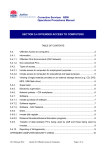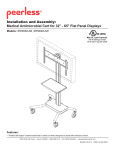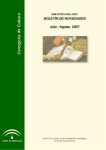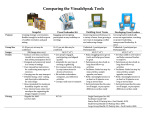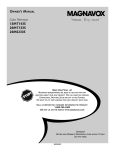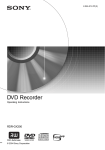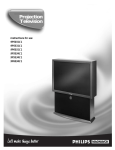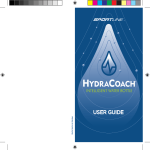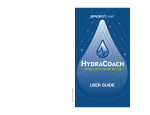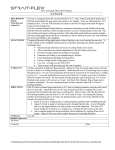Download Self Directed Learning User Guide for the FOODcents for Aboriginal
Transcript
Self Directed Learning User Guide for the FOODcents for Aboriginal and Torres Strait Islander People in WA Program A Guide to Promote Healthy Eating for Aboriginal & Torres Strait Islander People This User Guide is a supplement to the FOODcents for Aboriginal and Torres Strait Islander People in WA Program – A Guide to Promote Healthy Eating for Aboriginal & Torres Strait Islander People (the ‘ATSI FOODcents’ program) produced June 2004. Written By: Helen Sullivan and Carol Buchecker For further information on this manual, please contact: Nutrition Coordinator North Metropolitan Area Health Service Population Health PO Box S1296 Perth WA 6845 Phone: 08 9224 1625 Acknowledgments: The FOODcents for Aboriginal and Torres Strait Islander People in WA Project and the ATSI FOODcents Dissemination Project were both funded by Healthway. We thank everyone involved with developing and reviewing this guide. September, 2005 i Contents Introduction to the User Guide 1 Section One: Introduction and About the Program 2 Section Two: Planning Your Program 3 Section Three: The Program Introduction and Icebreakers Healthy Foods Activities Healthy Dollars Activities The Cook-Up Feedback Section Four: Appendix 1: ‘Deadly Tucker’ Cookbook Appendix 2: The Eat Healthy, Be Healthy Triangle Poster Appendix 3: Food Cards and Money Appendix 4: The (original) Food Cent$ Program 4 4 5-7 8-9 10 11 12 Appendix 1: True/False Questions 13-18 Appendix 2: True/False Answers 19-25 ii Introduction to the User Guide Purpose of the User Guide: The purpose of this ‘User Guide’ is to train Nutritionists and Health Promotion Officers to deliver the FOODcents Aboriginal and Torres Strait Islander (ATSI) People in WA Program, and to guide and support others to use the manual. The ‘User Guide’ is designed as a Self-Directed Learning package. The FOODcents for ATSI People in WA Program Manual (the Education Manual) contains four sections. These are ‘About the Program’, ‘Planning Your Program’, ‘The Program’ and Appendices. In this Guide, a brief overview of each is provided at the beginning of each section. Following the overview, you will then be guided to Action. Actions include Read, Review and Watch a Video. How to use the Guide: There are four steps: 1. Read the brief overview for each section. 2. Read the information or program session, or watch the video as directed in the Education Manual. 3. Complete the True/False review questions in User Guide Appendix 1. 4. Check your responses on the answer page in User Guide Appendix 2. ACTION: READ: WATCH VIDEO: REVIEW: TIME: • • • • À Use ‘The Guide to Your Session’ proforma (Education Manual, page 10) as you work through this User Guide. Make notes as you work through the manual, listing resources you need to obtain and highlighting areas that need extra preparation, eg obtaining local food prices. The approximate time to work through each section is indicated. The recommended time to work through this guide is about three hours. Work with a local indigenous person to deliver the program whenever possible. 1 Section One – About the Program À The suggested time for learning about this section is 15 minutes. Learning Outcome: At the end of this section you will have an understanding of the program’s origins, goals and strategies. Introduction: The FOODcents for ATSI people in WA Program is a North Metropolitan Area Health Service, Department of Health of WA initiative and funded by Healthway. The program was developed collaboratively with health representatives throughout WA. This program is an adaptation of the original FOODcents Program. About the Program: This section provides an overview of the program with information about program development, general information about working with ATSI people and consulting with the community. It includes basic information on adult learning and general information about how the program is implemented. The program is designed to enable flexibility in delivery. The program provides simple strategies to help increase effectiveness, eg • Deliver the program to an existing group where possible. Be flexible. • Establish a relationship with the group or group leaders prior to delivery by involving them in the planning. • Be aware of community dynamics, eg movements due to weather, funerals, lore time and community events. A good understanding of your community/group is essential in being able to effectively deliver the program. ACTION: Please read the ‘About the Manual’ section in the manual, pages 1-6. Review your reading using True/False questions - User Guide Appendix 1, page 13. Check your answers using Appendix 2, pages 19-20. 2 Section Two – Planning Your Program À The suggested time for learning about this section is 15 minutes. Learning Outcome: At the end of this section you will have the skills and tools to plan a FOODcents program for your community. This section provides information and tools to plan your program. A Session Guide (page 10) is included to assist with your planning. NB – Session Guides are guides only. Find out about the needs of your group and allow flexibility. A basic Session Checklist is included on page 12. We recommend this list be extended as needed. For example, include a time line and a responsibility nomination – that is when things will happen, and who is responsible. In your time line, ensure that you allow enough time for preparation. Have a clear understanding of what each activity is about and what it is trying to do. Build in flexibility. It is more important to ensure that the goals of your session are achieved, rather than how you deliver the program. The last part of section three in the manual provides information on collecting feedback. It is important to include time in your planning to review and evaluate your program. This will be discussed further in the next section. ACTION: Please read the ‘Planning Your Program’ section of the manual, pages 7-12. NB. Use the ‘Guide to Your Session’. Review your reading using True/False questions - User Guide Appendix 1, page 14. Check your answers using Appendix 2, pages 20-21. 3 Section Three – The Program À The suggested time for learning about this section is 120 minutes. Learning Outcome: At the end of this section you will have a clear understanding of the various program parts and activities. This will enable you to develop, implement and evaluate an ATSI FOODcents program for your community. The main parts are: Introduction Ice breakers Healthy Foods Activities Healthy Dollars Activities The Cook-Up Feedback/Evaluation Introduction and Ice Breakers: The relationship you have developed with the whole group, one of the community leaders or your liaison person will be invaluable in guiding you in developing your program’s introduction, and the icebreaker to use. You may have other icebreakers you prefer to use instead. Please note that some people are very intimidated by icebreakers. Always check first. ACTION: Please read ‘The Program’ section of the manual, pages 14-16. NB. Use the ‘Guide to Your Session’. Review your reading using True/False questions – User Guide Appendix 1, page 15. Check your answers using Appendix 2, pages 21-22. 4 Healthy Foods Activities: Learning Outcome: At the end of this section participants will have a clear understanding of, and be able to implement the five Healthy Foods activities. Activity 1: Old Ways, Today and New Ways… Activity 2: Looking at Your Diet Quiz Activity 3: The Eat Healthy, Be Healthy Diet Triangle (familiar) Activity 4: The Eat Healthy, Be Healthy Diet Triangle (not familiar) Activity 5: Jordan and Carla’s Moorditj Tucker Video Note: • The Education Manual is a living document; therefore innovation and experimentation are encouraged! This will ensure the activity is relevant and appropriate for your local community. • Always evaluate your sessions to guide your future programs. • Select the activity/activities that your group/community would respond well to. • You do not have to do all of the activities. Activity 1: Old Ways, Today and New Ways… The purpose of this activity is to show how the changes in the way people live now compared to the past has affected their health. ACTION: Please read the manual, pages 17-18. NB. Use the ‘Guide to Your Session’. Review your reading using True/False questions - User Guide Appendix 1, page 15. Check your answers using Appendix 2, page 22. 5 Activity 2: Looking at Your Diet Quiz This activity looks at some foods people may eat, how often they are eaten, and changes they could make to improve their diet. ACTION: Please read the manual, pages 19-23. NB. Use the ‘Guide to Your Session’. Review your reading using True/False questions - User Guide Appendix 1, page 16. Check your answers using Appendix 2, page 22. Activity 3: The Eat Healthy, Be Healthy Diet Triangle (familiar) Activity 4: The Eat Healthy, Be Healthy Diet Triangle (not familiar) In these activities the group will make an Eat Healthy, Be Healthy Triangle. It is important to know your group so that you can choose the activity that best suits them. ACTION: Please read the manual, pages 25-34. NB. Use the ‘Guide to Your Session’. Review your reading using True/False questions - User Guide Appendix 1, page 16. Check your answers using Appendix 2, page 23. 6 Activity 5: Jordan and Carla’s Moorditj Tucker Video This video targets children aged 8-14 years with messages about the benefits of good nutrition. The video can also be used with other groups. Consult with your community to ensure whether it is appropriate to use the video or not. It is recommended that you familiarise yourself with the Workbook, which accompanies the video. The Workbook has detailed information about session delivery incorporating the video. There are two sections in the workbook, one for teachers and one for Health Workers. Note: The video Jordan and Carla’s Moorditj Tucker includes a scene where basketball is being played. The actor “slam-dunks” the ball. Please ensure/remind participants that slam-dunking is not recommended and can be dangerous. ACTION: Please read the manual, page 35. NB. Use the ‘Guide to Your Session’. Watch video: Jordan and Carla’s Moorditj Tucker (12 minutes). Review your reading using True/False questions - User Guide Appendix 1, page 16. Check your answers using Appendix 2, page 23. (Time recommended does not include reading the video’s Workbook). 7 Healthy Dollars Activities: Learning Outcome: At the end of this section participants will be able to conduct the three Healthy Dollars activities. Activity: 6 Comparing Costs of Food. Activity: 7 Comparing Value for Money. Activity: 8 Buying Food the FOODcents Way (the 10–Plan). Note: • When selecting activities, use the information on page 37 together with your knowledge of your community/group to identify the most suitable activity. • Allow extra preparation time to prepare your resources when you first use them, as you will need time to make or collect them, eg pages 55–56; go to shops to collect current food prices for the Food Cards. • If you have not previously used the original FOODcents program, it is recommended that you read Appendix 4 of the Education Manual. • Cut out dollar coins ready for use. Cutting into squares is easier. Activity 6: Comparing Costs of Food This activity teaches value for money and is designed for those who find words and numbers difficult. ACTION: Please read the manual, pages 38-42. NB. Use the ‘Guide to Your Session’. Review your reading using True/False questions - User Guide Appendix 1, page 17. Check your answers using Appendix 2, page 23. 8 Activity 7: Comparing Value for Money This activity introduces the concept that some foods are better value for money. ACTION: Please read the manual, pages 43–50. NB. Use the ‘Guide to Your Session’. Review your reading using True/False questions - User Guide Appendix 1, page 17. Check your answers using Appendix 2, page 24. Activity 8: Buying Food the FOODcents Way (the 10-Plan) This Healthy Dollar activity is for those with a better understanding of numbers and introduces the food triangle into the budget. ACTION: Please read the manual, pages 51-56. NB. Use the ‘Guide to Your Session’. Review your reading using True/False questions - User Guide Appendix 1, page 17. Check your answers using Appendix 2, page 24. 9 The Cook-Up Learning Outcome: At the end of this section participants will be able to plan and deliver the Cook-Up activity. Note: • A variation of the activity is to plan a menu with the group before the Cook-Up session and involve them with the purchase of ingredients. This is an opportunity to reinforce learning from previous activities, eg Healthy Dollars activities. • Allow plenty of time for preparation, eg selecting recipes, preparing your shopping list, cooking equipment list and organising the venue. Use the Checklists and Shopping Lists on pages 60–63 to help you. • Familiarise yourself with the ‘Deadly Tucker’ Cookbook (Education Manual Appendix 1). These recipes are easy to prepare and are low cost. They have been rated for people with diabetes so that: J JJ L • • • Good for people with diabetes Excellent for people with diabetes Not okay for people with diabetes Recipes include Soups, Main Dishes, Salads & Vegetables and Desserts & Other Sweet Things. Also included are ideas for stretching the meal when you need to feed more people. Other recipes maybe used. Encourage participants to share their own recipes before the session for you to check. ACTION: Please read the manual, pages 57-63. NB. Use the ‘Guide to Your Session’. Review your reading using True/False questions - User Guide Appendix 1, page 18. Check your answers using Appendix 2, pages 24-25. 10 Feedback Learning Outcome: At the end of this section you will have an overview of evaluation for the ATSI FOODcents program. Note: • Evaluation of the activity is achieved through ‘question and answer’ at the end of the session, as well as observation and participation levels. • The form on page 67 can be used as a starting point for preparing your evaluation report. Include additional information as required. ACTION: Please read the manual, pages 64-67. NB. Use the ‘Guide to Your Session’. Review your reading using True/False questions - User Guide Appendix 1, page 18. Check your answers using Appendix 2, page 25. 11 Section Four: Appendices There are four Appendices in the ATSI FOODcents Manual. These are: Appendix 1: ‘Deadly Tucker’ Cookbook Appendix 2: The Eat Healthy, Be Healthy Triangle Poster Appendix 3: Food Cards and Money Appendix 4: The (original) Food Cent$ Program 12 User Guide Appendix 1 – True/False Questions Please circle the correct response. Section 1: About the Program 1 True False The aim of the FOODcents program is to adapt, test and disseminate FOODcents for ATSI people throughout WA. 2 True False The program has been designed as a living document that will evolve as communities and practitioners work with it. 3 True False All Torres Strait Islander people have the same eating habits and beliefs and this program has been designed specifically for them. 4 True False All ATSI people have the same literacy and numeracy skills. 5 True False English is the primary language of all ATSI people. 6 True False Developing a relationship with communities prior to implementing the program is essential. 7 True False Before you visit a community, check that it is still OK to do so. A death in the community or another event may mean you will have to make changes to your planned program. 8 True False Program information needs to be presented exactly as stated in the Education Manual. 9 True False Working in groups can assist in people learning from each other. 10 True False The program is designed as a one-off session only. 11 True False Presenters should set up a new group specifically for the program. 12 True False Choose activities from the manual, but adapt them to suit the group you are working with. 13 Section 2: Planning Your Program 1 True False Planning is vital to the success of the session and program. 2 True False Before your session it is important to know - Who? Where? Why? 3 True False Choosing activities is entirely up to the presenter. 4 True False Choosing activities is entirely up to the group. 5 True False Choice of activities is made in consultation with the presenter and community or group representatives. 6 True False Each session should have an Introduction, an Icebreaker, Activities and Feedback. 7 True False The program should include at least one Healthy Foods activity and a Healthy Dollars activity, followed by a Cook-Up if possible. 8 True False The use of the tool “Guide to Your Session” (page 10) is necessary only when it is your first presentation. 9 True False The number of activities you do will depend on the time you have for each session. 10 True False A checklist is only required if you are not an organised practitioner. 11 True False If time is limited you can prepare some or all of the ingredients before the session, eg peel and cut up vegetables. 12 True False All sessions must include an icebreaker. 14 Section 3: The Program Healthy Foods Activities Introduction and Icebreakers 1 True False The introduction includes a brief explanation about FOODcents and how the program started. 2 True False FOODcents introduces a new way to balance our diet and food budget. 3 True False FOODcents was first developed in Albany in 1992. 4 True False Three out of ten deaths are related to poor diet. 5 True False Indigenous men only live to 56 years of age compared to 77 years for all Australian men. 6 True False Aboriginal people are less likely to develop diabetes. 7 True False Prior knowledge of the group is not relevant when choosing an icebreaker. 8 True False Icebreakers are used to make people feel comfortable with each other. 9 True False Icebreakers are an excellent way for the presenter to get to know the group. Activity 1 - Old Ways, Today and New Ways… 1 True False This activity enables the group to look at the differences in lifestyle and diet from the past to now. 2 True False This activity can initiate discussion about the relationship between the way we live and disease. 3 True False This activity does not teach skills to avoid lifestyle diseases. 15 Activity 2 – Looking at Your Diet Quiz 1 True False This activity looks at some foods people eat and how often they are eaten. This gives a visual representation of how their diet compares to a healthy diet. 2 True False This activity is suitable for people who do not read well and have problems with numbers. 3 True False All resources you need for this activity are included in the manual. Activity 3 and 4 - The Eat Healthy, Be Healthy Triangle (familiar, not familiar) 1 True False Activity 3 and 4 is for those that know and understand the Eat Healthy, Be Healthy Triangle. 2 True False During this activity participants place food onto sections of the triangle. After all the foods have been placed, the presenter leads discussion on the appropriate placement of the food and why they are there. Activity 5 - Jordan and Carla’s Moorditj Tucker Video 1 True False This activity is directed towards children between 8 to 14 years with messages about ‘muscle power’, ‘brain power’, ‘play power’, and ‘power in looking good’. 2 True False This video can be shown to all groups. 3 True False This video is suitable for people living in the city and the country. 16 Activity 6 - Comparing Costs of Food 1 True False This activity introduces value for money by using food packages and comparing packaging, weight and cost. 2 True False This activity is for those who find words and numbers easy. 3 True False Healthy foods are more expensive than unhealthy foods. 4 True False This activity needs funding to purchase sample food items, or you need to bring packets of food items from home. Activity 7 - Comparing Value for Money 1 True False This activity looks at value for money using a ‘shopping’ exercise within the group. 2 True False This activity reinforces that money spent on ‘Eat Less’ foods will feed more people and keep people from getting sick. 3 True False This activity will not need funding, but you will need to check current prices of foods for the Food Cards. Activity 8 - Buying Food the FOODcents Way (the 10-Plan) 1 True False This activity teaches principles of the 10-Plan. 2 True False An option is to add cigarettes and alcohol into the spending to see what foods cannot be afforded if buying cigarettes and alcohol. 3 True False The 10-Plan demonstrates where food money is spent in relation to the Eat Healthy, Be Healthy Triangle. This introduces the Food Triangle into the budget. 17 The Cook-Up 1 True False This session is a practical session demonstrating how healthy, low cost meals can be prepared. 2 True False Food safety and food handling are not an integral part of the session. 3 True False The Cook-Up shows ways of making healthy food go further – to feed more people. 4 True False The Cook-Up is an opportunity to reinforce other messages and budgeting information. False Evaluating your session provides you with feedback and assists with planning future programs. Feedback 1 True 18 User Guide Appendix 2 – True/False Answers For questions that are false, the correct answer is given in italics. Section 1: About the Program 1 True The aim of the FOODcents program is to adapt, test and disseminate FOODcents for ATSI people throughout WA. 2 True The program has been designed as a living document that will evolve as communities and practitioners work with it. 3 False All Torres Strait Islander people have the same eating habits and beliefs and this program has been designed specifically for them. There are differences in the culture of the Torres Strait Islander people therefore further development may be needed to meet the needs of this group. 4 False All ATSI people have the same literacy and numeracy skills. The differences in ATSI communities are not only where they are located but also in their ability to read, to understand numbers and to handle money. It is important to know your community to ensure activities conducted are relevant for your group. 5 False English is the primary language of all ATSI people. Communities in more remote areas may have English as a second language. 6 True Developing a relationship with communities prior to implementing the program is essential. 7 True Before you visit a community, check that it is still OK to do so. A death in the community or another event may mean you will have to make changes to your planned program. 8 False Program information needs to be presented exactly as stated in the Education Manual. This program is designed as a living document that will evolve as communities work with it. It is a flexible program, activities can be changed and modified as needed. 19 9 True Working in groups can assist in people learning from each other. 10 False The program is designed as a one-off session only. Depending on community interest, the program can be run as a one-off session, or you can run several sessions. You can also conduct activities one-on-one where appropriate. 11 False Presenters should set up a new group specifically for the program. Existing groups who meet regularly can be accessed. 12 True Choose activities from the manual, but adapt them to suit the group you are working with. Section 2: Planning Your Program 1 True Planning is vital to the success of the session and program. 2 False Before your session it is important to know - Who? Where? Why? “When” has been left out. When is just as important. 3 False Choosing activities is entirely up to the presenter. Activities are chosen in consultation. 4 False Choosing activities is entirely up to the group. Activities are chosen in consultation. 5 True Choice of activities is made in consultation with the presenter and community or group representatives. 6 False Each session should have an Introduction, an Icebreaker, Activities and Feedback. Some people are very intimidated by icebreakers. Find out whether an icebreaker is suitable. An icebreaker may be unnecessary if you know your group, and/or participants all know each other. 7 True The program should include at least one Healthy Foods activity and a Healthy Dollars activity, followed by a Cook-Up if possible. 20 8 False The use of the tool “Guide to Your Session” (page 10) is necessary only when it is your first presentation. Preparing a Guide for each session ensures your session is planned thoroughly and you have the correct resources. It can also be part of your evaluation process. 9 True The number of activities you do will depend on the time you have for each session. 10 False A checklist is only required if you are not an organised practitioner. A checklist ensures your session runs smoothly. 11 True If time is limited you can prepare some or all of the ingredients before the session, eg peel and cut up vegetables. 12 False All sessions must include an icebreaker. Some people are very intimidated by an icebreaker. Find out whether an icebreaker is suitable. An icebreaker may be unnecessary if you know your group, and/or participants all know each other. Section 3: The Program Introduction and Icebreakers 1 True The introduction includes a brief explanation about FOODcents and how the program started. 2 True FOODcents introduces a new way to balance our diet and food budget. 3 True FOODcents was first developed in Albany in 1992. 4 False Three out of ten deaths are related to poor diet. Six out of ten deaths are related to poor diet. 5 True Indigenous men only live to 56 years of age compared to 77 years for all Australian men. 6 False Aboriginal people are less likely to develop diabetes. An Aboriginal person is 10 times more likely to get diabetes. 21 7 False Prior knowledge of the group is not relevant when choosing an icebreaker. Prior knowledge of the group is important when choosing whether to include an icebreaker and what type to use. 8 True Icebreakers are used to make people feel comfortable with each other. 9 True Icebreakers are an excellent way for the presenter to get to know the group. Activity 1 - Old Ways, Today and New Ways… 1 True This activity enables the group to look at the differences in lifestyle and diet from the past to now. 2 True This activity can initiate discussion about the relationship between the way we live and disease. 3 False This activity does not teach skills to avoid lifestyle diseases. This activity does allow participants an opportunity to discuss how to avoid lifestyle diseases. Activity 2 - Looking at Your Diet Quiz 1 True This activity looks at some foods people eat and how often they are eaten. This gives a visual representation of how their diet compares to a healthy diet. 2 True This activity is suitable for people who do not read well and have problems with numbers. 3 False All resources you need for this activity are included in the manual. Coloured stickers or coloured pens are required for this activity. 22 Activity 3 and 4 - The Eat Healthy, Be Healthy Triangle (familiar, not familiar) 1 False Activity 3 and 4 is for those that know and understand the Eat Healthy, Be Healthy Triangle. Activity 4 is for groups who do not have a good knowledge and understanding of the Eat Healthy, Be Healthy Triangle. 2 True During this activity participants place food onto sections of the triangle. After all the foods have been placed, the presenter leads discussion on the appropriate placement of the food and why they are there. Activity 5 - Jordan and Carla’s Moorditj Tucker Video 1 True This activity is directed towards children between 8 to 14 years with messages about ‘muscle power’, ‘brain power’, ‘play power’, and ‘power in looking good’. 2 False This video can be shown to all groups. This video is not suitable for all groups, review the video and use if appropriate. 3 False This video is suitable for people living in the city and the country. This video was made in the city but could be shown in the country. Review the video with a community representative to determine suitability. Activity 6 - Comparing Costs of Food 1 True This activity introduces value for money by using food packages and comparing packaging, weight and cost. 2 False This activity is for those who find words and numbers easy. This activity is suitable for people who have difficulties with literacy and/or numeracy skills. 3 False Healthy foods are more expensive than unhealthy foods. Healthy foods are usually less expensive. 4 True This activity needs funding to purchase sample food items, or you need to bring packets of food items from home. 23 Activity 7 - Comparing Value for Money 1 True This activity looks at value for money using a ‘shopping’ exercise within the group. 2 False This activity reinforces that money spent on ‘Eat Less’ foods will feed more people and keep people from getting sick. This activity reinforces that money spent on ‘Eat Most’ foods will feed more people and keep people from getting sick. 3 False This activity will not need funding, but you will need to check current prices of foods for the Food Cards. This activity suggests you have $20 of real ‘Eat Most’ and ‘Eat Some’ foods and $20 of real ‘Eat Less’ and ‘Eat Some’ foods. Spending money to buy real food is optional. You can use the Food Cards instead. Activity 8 - Buying Food the FOODcents Way (the 10-Plan) 1 True This activity teaches principles of the 10-Plan. 2 True An option is to add cigarettes and alcohol into the spending to see what foods cannot be afforded if buying cigarettes and alcohol. 3 True The 10-Plan demonstrates where food money is spent in relation to the Eat Healthy, Be Healthy Triangle. This introduces the Food Triangle into the budget. Activity 9 - The Cook-Up 1 True This session is a practical session demonstrating how healthy, low cost meals can be prepared. 2 False Food safety and food handling are not an integral part of the session. Food safety and food handling are an integral part of the session. guide to keeping foods safe is found in the ‘Deadly Tucker’ Cookbook. 3 True A The Cook-Up shows ways of making healthy food go further – to feed more people. 24 4 True The Cook-Up is an opportunity to reinforce other messages and budgeting information. Feedback 1 True Evaluating your session provides you with feedback and assists with planning future programs. 25




























